Evaluating Gig Economy and Its Impact
VerifiedAdded on 2021/04/24
|10
|2578
|78
AI Summary
The given assignment is about evaluating the gig economy and its impact on society. It discusses the opportunities provided by the gig economy, such as attaining a utopian society, but also highlights the adverse effects it can cause, including ethical dilemmas that might lead to dystopia. The proposed control mechanism can help organizations retain their control over employees and mitigate issues related to the gig economy.
Contribute Materials
Your contribution can guide someone’s learning journey. Share your
documents today.
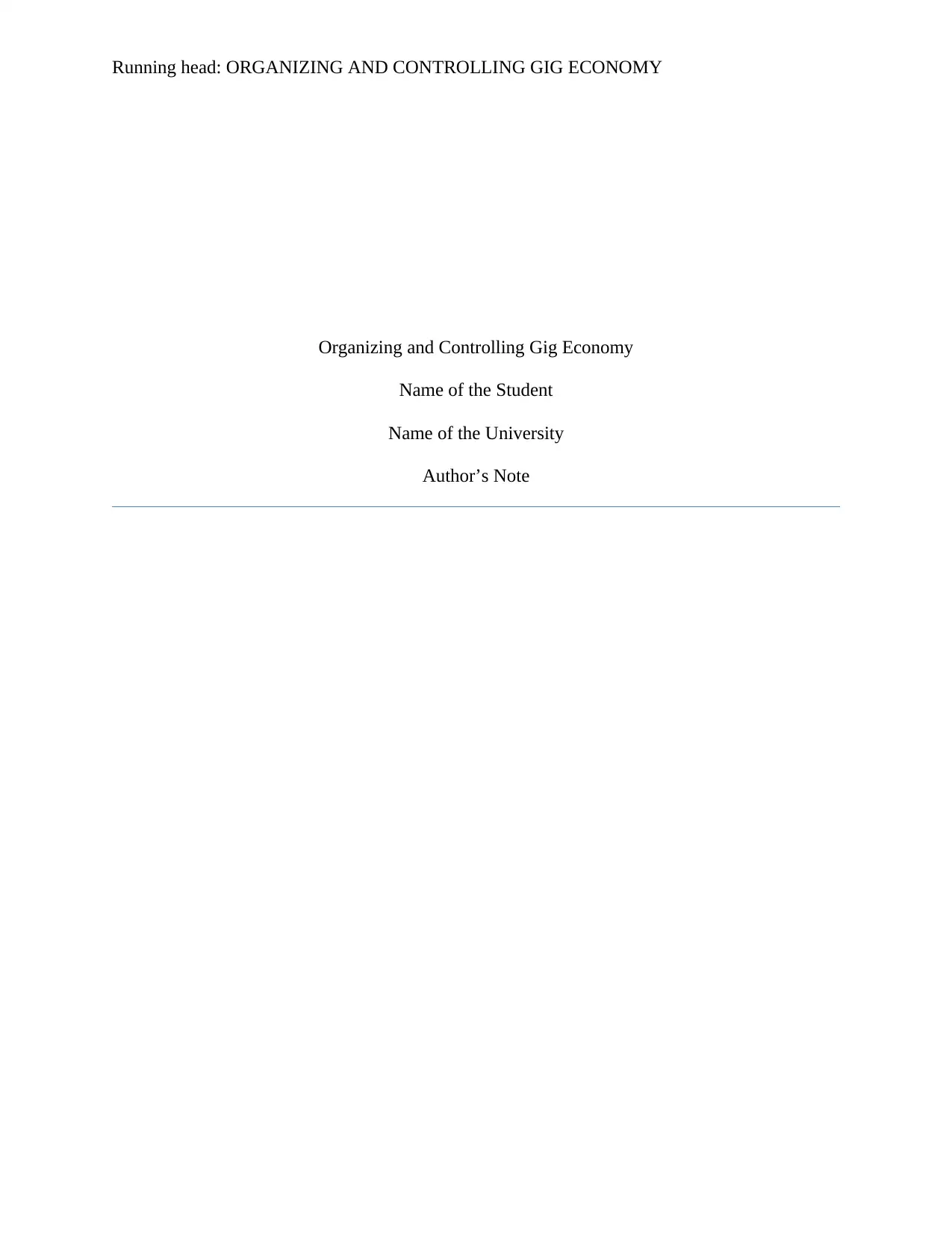
Running head: ORGANIZING AND CONTROLLING GIG ECONOMY
Organizing and Controlling Gig Economy
Name of the Student
Name of the University
Author’s Note
Organizing and Controlling Gig Economy
Name of the Student
Name of the University
Author’s Note
Secure Best Marks with AI Grader
Need help grading? Try our AI Grader for instant feedback on your assignments.
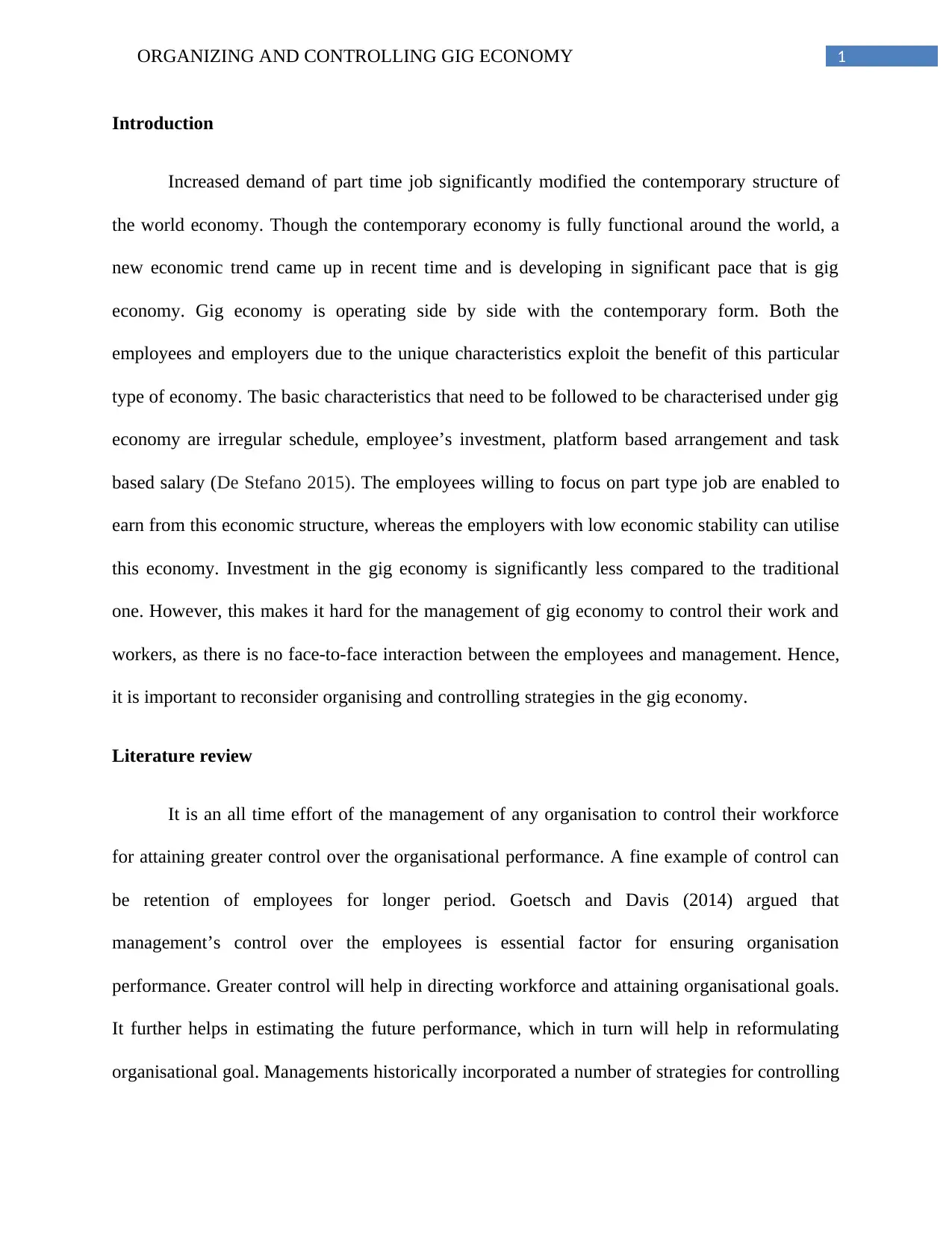
1ORGANIZING AND CONTROLLING GIG ECONOMY
Introduction
Increased demand of part time job significantly modified the contemporary structure of
the world economy. Though the contemporary economy is fully functional around the world, a
new economic trend came up in recent time and is developing in significant pace that is gig
economy. Gig economy is operating side by side with the contemporary form. Both the
employees and employers due to the unique characteristics exploit the benefit of this particular
type of economy. The basic characteristics that need to be followed to be characterised under gig
economy are irregular schedule, employee’s investment, platform based arrangement and task
based salary (De Stefano 2015). The employees willing to focus on part type job are enabled to
earn from this economic structure, whereas the employers with low economic stability can utilise
this economy. Investment in the gig economy is significantly less compared to the traditional
one. However, this makes it hard for the management of gig economy to control their work and
workers, as there is no face-to-face interaction between the employees and management. Hence,
it is important to reconsider organising and controlling strategies in the gig economy.
Literature review
It is an all time effort of the management of any organisation to control their workforce
for attaining greater control over the organisational performance. A fine example of control can
be retention of employees for longer period. Goetsch and Davis (2014) argued that
management’s control over the employees is essential factor for ensuring organisation
performance. Greater control will help in directing workforce and attaining organisational goals.
It further helps in estimating the future performance, which in turn will help in reformulating
organisational goal. Managements historically incorporated a number of strategies for controlling
Introduction
Increased demand of part time job significantly modified the contemporary structure of
the world economy. Though the contemporary economy is fully functional around the world, a
new economic trend came up in recent time and is developing in significant pace that is gig
economy. Gig economy is operating side by side with the contemporary form. Both the
employees and employers due to the unique characteristics exploit the benefit of this particular
type of economy. The basic characteristics that need to be followed to be characterised under gig
economy are irregular schedule, employee’s investment, platform based arrangement and task
based salary (De Stefano 2015). The employees willing to focus on part type job are enabled to
earn from this economic structure, whereas the employers with low economic stability can utilise
this economy. Investment in the gig economy is significantly less compared to the traditional
one. However, this makes it hard for the management of gig economy to control their work and
workers, as there is no face-to-face interaction between the employees and management. Hence,
it is important to reconsider organising and controlling strategies in the gig economy.
Literature review
It is an all time effort of the management of any organisation to control their workforce
for attaining greater control over the organisational performance. A fine example of control can
be retention of employees for longer period. Goetsch and Davis (2014) argued that
management’s control over the employees is essential factor for ensuring organisation
performance. Greater control will help in directing workforce and attaining organisational goals.
It further helps in estimating the future performance, which in turn will help in reformulating
organisational goal. Managements historically incorporated a number of strategies for controlling
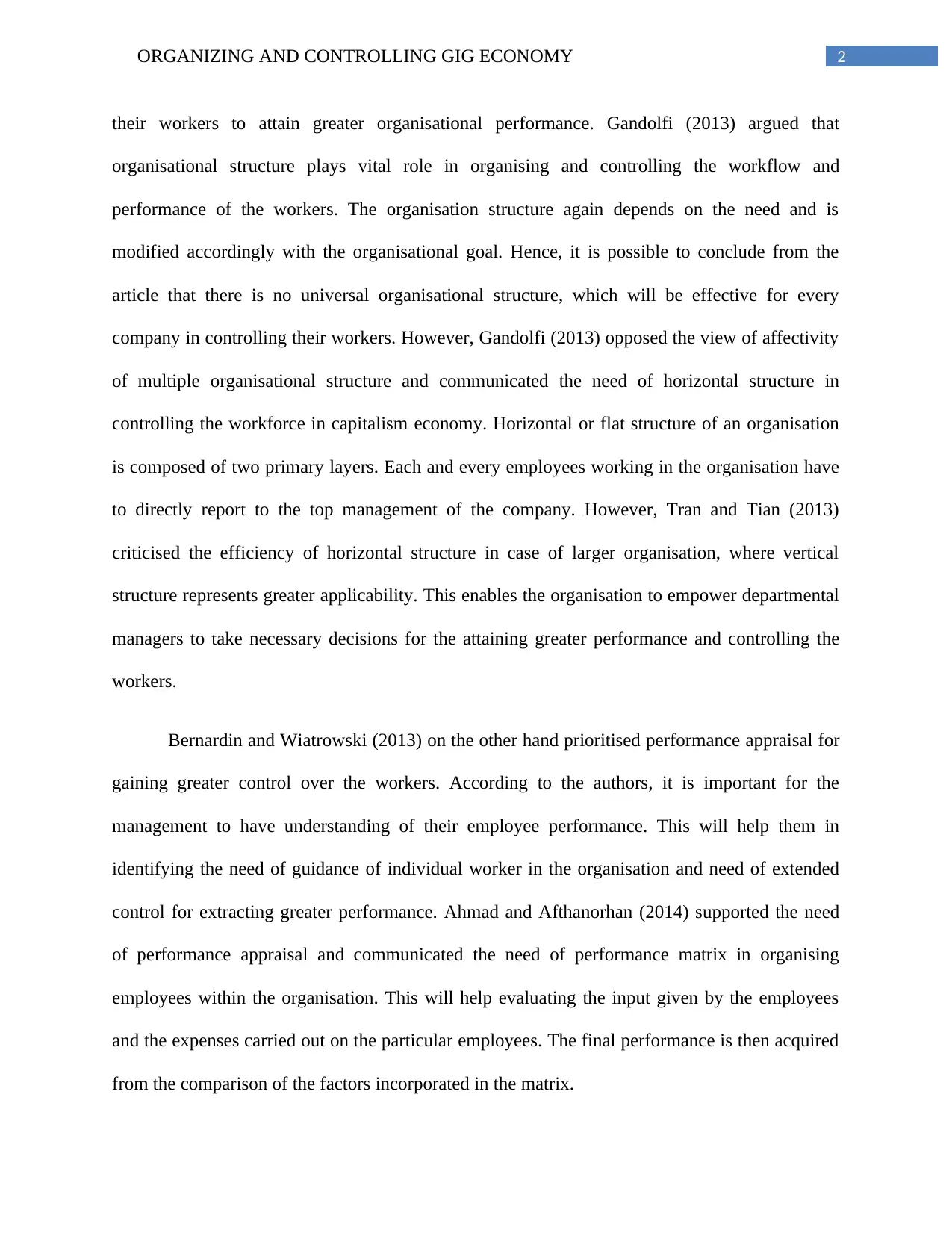
2ORGANIZING AND CONTROLLING GIG ECONOMY
their workers to attain greater organisational performance. Gandolfi (2013) argued that
organisational structure plays vital role in organising and controlling the workflow and
performance of the workers. The organisation structure again depends on the need and is
modified accordingly with the organisational goal. Hence, it is possible to conclude from the
article that there is no universal organisational structure, which will be effective for every
company in controlling their workers. However, Gandolfi (2013) opposed the view of affectivity
of multiple organisational structure and communicated the need of horizontal structure in
controlling the workforce in capitalism economy. Horizontal or flat structure of an organisation
is composed of two primary layers. Each and every employees working in the organisation have
to directly report to the top management of the company. However, Tran and Tian (2013)
criticised the efficiency of horizontal structure in case of larger organisation, where vertical
structure represents greater applicability. This enables the organisation to empower departmental
managers to take necessary decisions for the attaining greater performance and controlling the
workers.
Bernardin and Wiatrowski (2013) on the other hand prioritised performance appraisal for
gaining greater control over the workers. According to the authors, it is important for the
management to have understanding of their employee performance. This will help them in
identifying the need of guidance of individual worker in the organisation and need of extended
control for extracting greater performance. Ahmad and Afthanorhan (2014) supported the need
of performance appraisal and communicated the need of performance matrix in organising
employees within the organisation. This will help evaluating the input given by the employees
and the expenses carried out on the particular employees. The final performance is then acquired
from the comparison of the factors incorporated in the matrix.
their workers to attain greater organisational performance. Gandolfi (2013) argued that
organisational structure plays vital role in organising and controlling the workflow and
performance of the workers. The organisation structure again depends on the need and is
modified accordingly with the organisational goal. Hence, it is possible to conclude from the
article that there is no universal organisational structure, which will be effective for every
company in controlling their workers. However, Gandolfi (2013) opposed the view of affectivity
of multiple organisational structure and communicated the need of horizontal structure in
controlling the workforce in capitalism economy. Horizontal or flat structure of an organisation
is composed of two primary layers. Each and every employees working in the organisation have
to directly report to the top management of the company. However, Tran and Tian (2013)
criticised the efficiency of horizontal structure in case of larger organisation, where vertical
structure represents greater applicability. This enables the organisation to empower departmental
managers to take necessary decisions for the attaining greater performance and controlling the
workers.
Bernardin and Wiatrowski (2013) on the other hand prioritised performance appraisal for
gaining greater control over the workers. According to the authors, it is important for the
management to have understanding of their employee performance. This will help them in
identifying the need of guidance of individual worker in the organisation and need of extended
control for extracting greater performance. Ahmad and Afthanorhan (2014) supported the need
of performance appraisal and communicated the need of performance matrix in organising
employees within the organisation. This will help evaluating the input given by the employees
and the expenses carried out on the particular employees. The final performance is then acquired
from the comparison of the factors incorporated in the matrix.
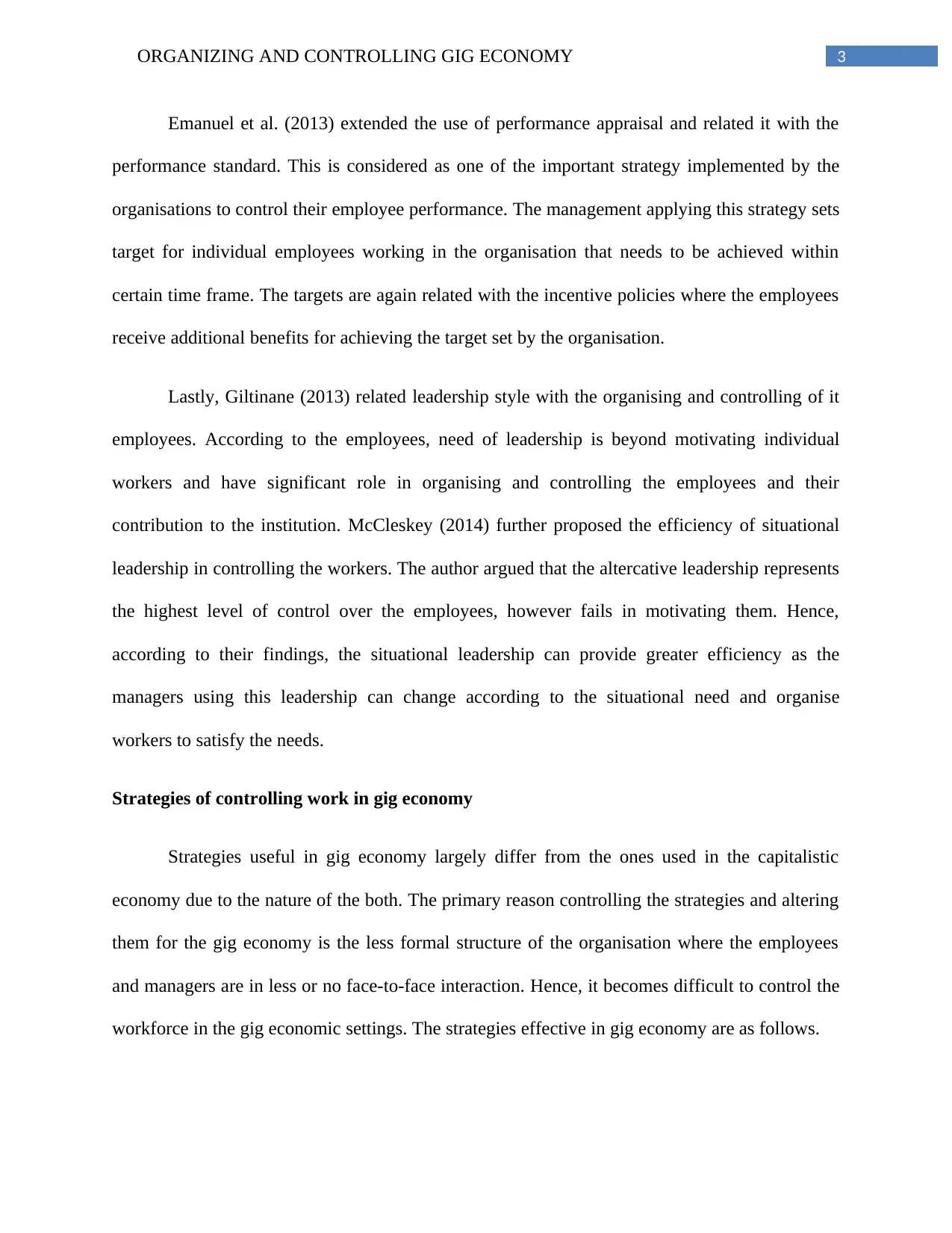
3ORGANIZING AND CONTROLLING GIG ECONOMY
Emanuel et al. (2013) extended the use of performance appraisal and related it with the
performance standard. This is considered as one of the important strategy implemented by the
organisations to control their employee performance. The management applying this strategy sets
target for individual employees working in the organisation that needs to be achieved within
certain time frame. The targets are again related with the incentive policies where the employees
receive additional benefits for achieving the target set by the organisation.
Lastly, Giltinane (2013) related leadership style with the organising and controlling of it
employees. According to the employees, need of leadership is beyond motivating individual
workers and have significant role in organising and controlling the employees and their
contribution to the institution. McCleskey (2014) further proposed the efficiency of situational
leadership in controlling the workers. The author argued that the altercative leadership represents
the highest level of control over the employees, however fails in motivating them. Hence,
according to their findings, the situational leadership can provide greater efficiency as the
managers using this leadership can change according to the situational need and organise
workers to satisfy the needs.
Strategies of controlling work in gig economy
Strategies useful in gig economy largely differ from the ones used in the capitalistic
economy due to the nature of the both. The primary reason controlling the strategies and altering
them for the gig economy is the less formal structure of the organisation where the employees
and managers are in less or no face-to-face interaction. Hence, it becomes difficult to control the
workforce in the gig economic settings. The strategies effective in gig economy are as follows.
Emanuel et al. (2013) extended the use of performance appraisal and related it with the
performance standard. This is considered as one of the important strategy implemented by the
organisations to control their employee performance. The management applying this strategy sets
target for individual employees working in the organisation that needs to be achieved within
certain time frame. The targets are again related with the incentive policies where the employees
receive additional benefits for achieving the target set by the organisation.
Lastly, Giltinane (2013) related leadership style with the organising and controlling of it
employees. According to the employees, need of leadership is beyond motivating individual
workers and have significant role in organising and controlling the employees and their
contribution to the institution. McCleskey (2014) further proposed the efficiency of situational
leadership in controlling the workers. The author argued that the altercative leadership represents
the highest level of control over the employees, however fails in motivating them. Hence,
according to their findings, the situational leadership can provide greater efficiency as the
managers using this leadership can change according to the situational need and organise
workers to satisfy the needs.
Strategies of controlling work in gig economy
Strategies useful in gig economy largely differ from the ones used in the capitalistic
economy due to the nature of the both. The primary reason controlling the strategies and altering
them for the gig economy is the less formal structure of the organisation where the employees
and managers are in less or no face-to-face interaction. Hence, it becomes difficult to control the
workforce in the gig economic settings. The strategies effective in gig economy are as follows.
Secure Best Marks with AI Grader
Need help grading? Try our AI Grader for instant feedback on your assignments.
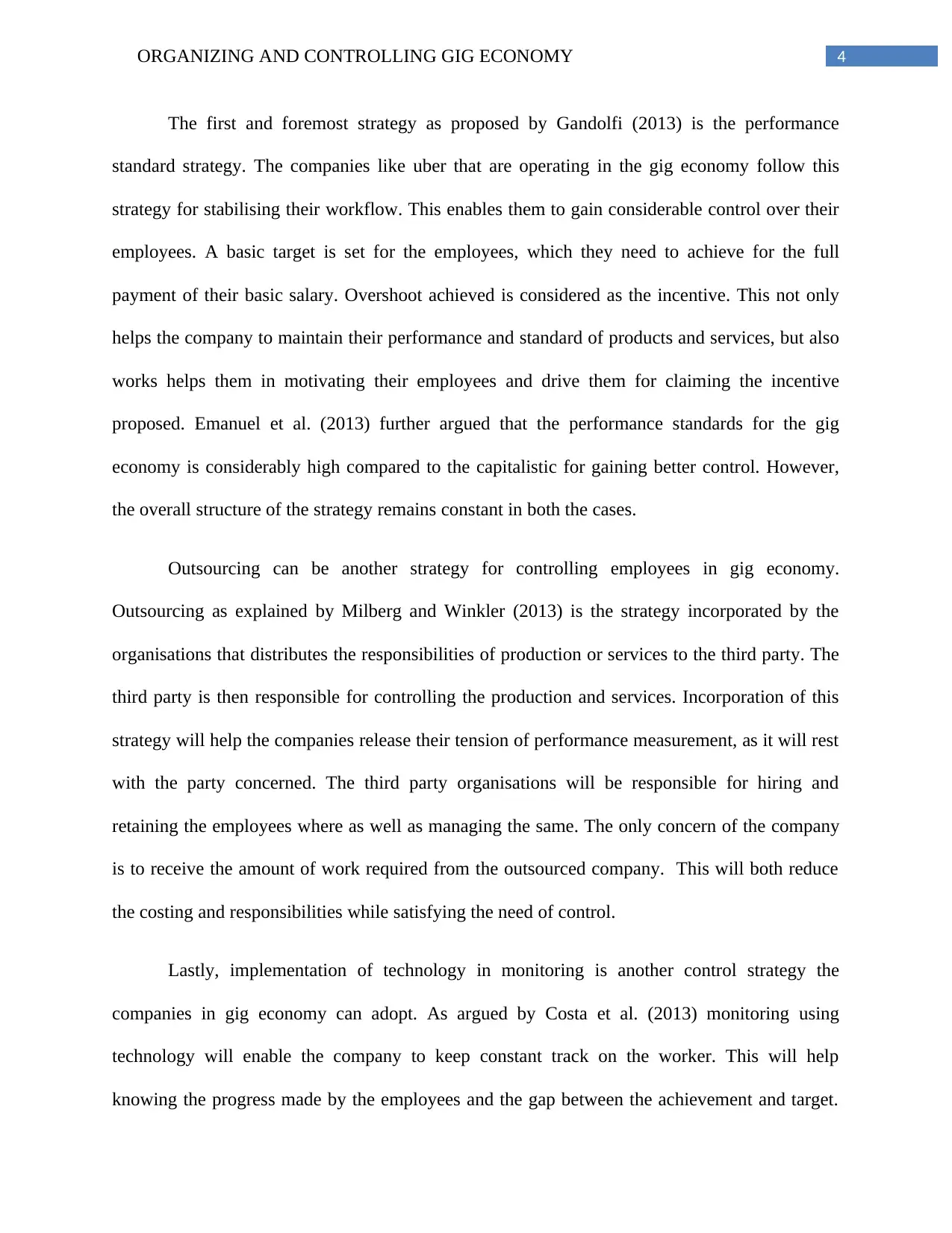
4ORGANIZING AND CONTROLLING GIG ECONOMY
The first and foremost strategy as proposed by Gandolfi (2013) is the performance
standard strategy. The companies like uber that are operating in the gig economy follow this
strategy for stabilising their workflow. This enables them to gain considerable control over their
employees. A basic target is set for the employees, which they need to achieve for the full
payment of their basic salary. Overshoot achieved is considered as the incentive. This not only
helps the company to maintain their performance and standard of products and services, but also
works helps them in motivating their employees and drive them for claiming the incentive
proposed. Emanuel et al. (2013) further argued that the performance standards for the gig
economy is considerably high compared to the capitalistic for gaining better control. However,
the overall structure of the strategy remains constant in both the cases.
Outsourcing can be another strategy for controlling employees in gig economy.
Outsourcing as explained by Milberg and Winkler (2013) is the strategy incorporated by the
organisations that distributes the responsibilities of production or services to the third party. The
third party is then responsible for controlling the production and services. Incorporation of this
strategy will help the companies release their tension of performance measurement, as it will rest
with the party concerned. The third party organisations will be responsible for hiring and
retaining the employees where as well as managing the same. The only concern of the company
is to receive the amount of work required from the outsourced company. This will both reduce
the costing and responsibilities while satisfying the need of control.
Lastly, implementation of technology in monitoring is another control strategy the
companies in gig economy can adopt. As argued by Costa et al. (2013) monitoring using
technology will enable the company to keep constant track on the worker. This will help
knowing the progress made by the employees and the gap between the achievement and target.
The first and foremost strategy as proposed by Gandolfi (2013) is the performance
standard strategy. The companies like uber that are operating in the gig economy follow this
strategy for stabilising their workflow. This enables them to gain considerable control over their
employees. A basic target is set for the employees, which they need to achieve for the full
payment of their basic salary. Overshoot achieved is considered as the incentive. This not only
helps the company to maintain their performance and standard of products and services, but also
works helps them in motivating their employees and drive them for claiming the incentive
proposed. Emanuel et al. (2013) further argued that the performance standards for the gig
economy is considerably high compared to the capitalistic for gaining better control. However,
the overall structure of the strategy remains constant in both the cases.
Outsourcing can be another strategy for controlling employees in gig economy.
Outsourcing as explained by Milberg and Winkler (2013) is the strategy incorporated by the
organisations that distributes the responsibilities of production or services to the third party. The
third party is then responsible for controlling the production and services. Incorporation of this
strategy will help the companies release their tension of performance measurement, as it will rest
with the party concerned. The third party organisations will be responsible for hiring and
retaining the employees where as well as managing the same. The only concern of the company
is to receive the amount of work required from the outsourced company. This will both reduce
the costing and responsibilities while satisfying the need of control.
Lastly, implementation of technology in monitoring is another control strategy the
companies in gig economy can adopt. As argued by Costa et al. (2013) monitoring using
technology will enable the company to keep constant track on the worker. This will help
knowing the progress made by the employees and the gap between the achievement and target.
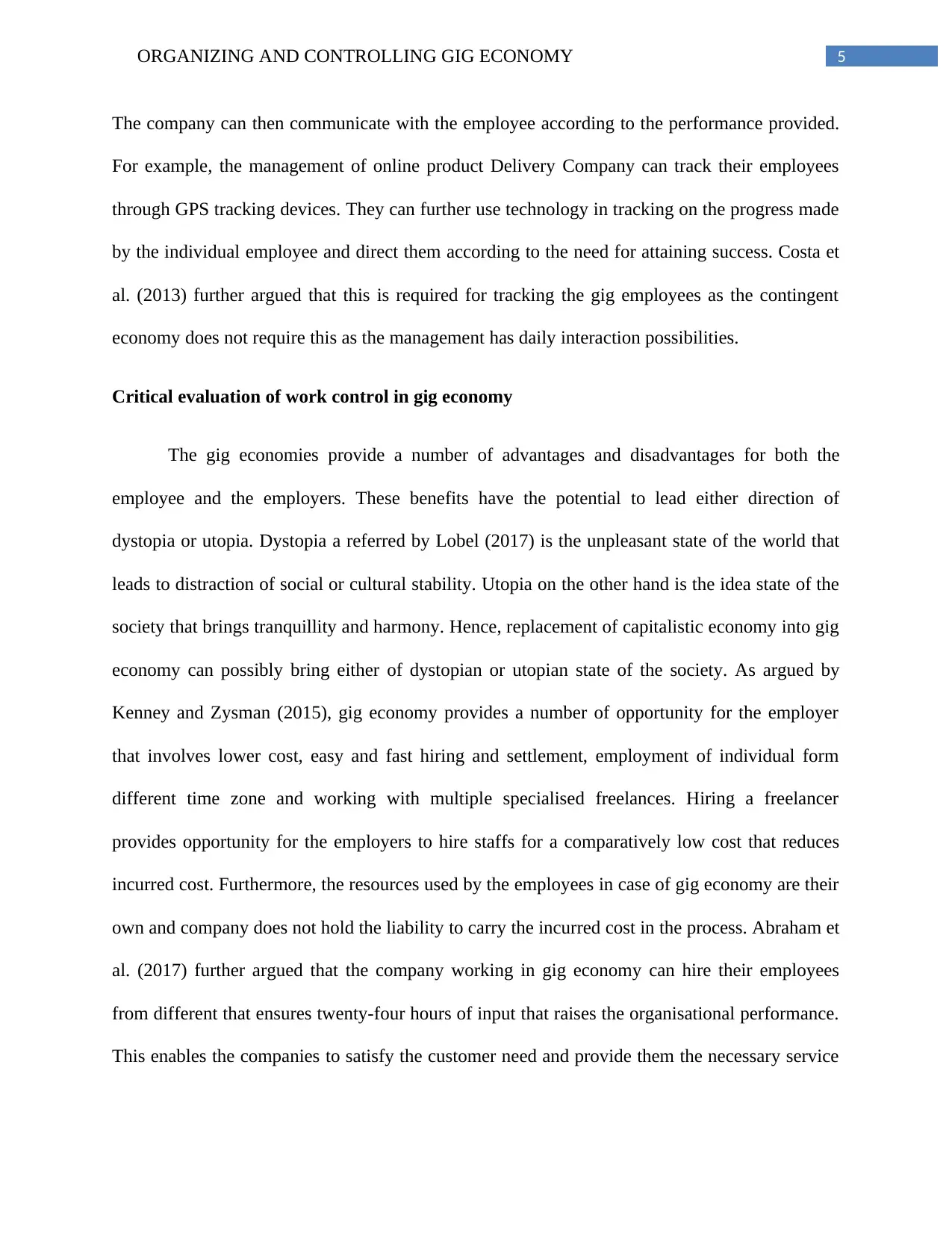
5ORGANIZING AND CONTROLLING GIG ECONOMY
The company can then communicate with the employee according to the performance provided.
For example, the management of online product Delivery Company can track their employees
through GPS tracking devices. They can further use technology in tracking on the progress made
by the individual employee and direct them according to the need for attaining success. Costa et
al. (2013) further argued that this is required for tracking the gig employees as the contingent
economy does not require this as the management has daily interaction possibilities.
Critical evaluation of work control in gig economy
The gig economies provide a number of advantages and disadvantages for both the
employee and the employers. These benefits have the potential to lead either direction of
dystopia or utopia. Dystopia a referred by Lobel (2017) is the unpleasant state of the world that
leads to distraction of social or cultural stability. Utopia on the other hand is the idea state of the
society that brings tranquillity and harmony. Hence, replacement of capitalistic economy into gig
economy can possibly bring either of dystopian or utopian state of the society. As argued by
Kenney and Zysman (2015), gig economy provides a number of opportunity for the employer
that involves lower cost, easy and fast hiring and settlement, employment of individual form
different time zone and working with multiple specialised freelances. Hiring a freelancer
provides opportunity for the employers to hire staffs for a comparatively low cost that reduces
incurred cost. Furthermore, the resources used by the employees in case of gig economy are their
own and company does not hold the liability to carry the incurred cost in the process. Abraham et
al. (2017) further argued that the company working in gig economy can hire their employees
from different that ensures twenty-four hours of input that raises the organisational performance.
This enables the companies to satisfy the customer need and provide them the necessary service
The company can then communicate with the employee according to the performance provided.
For example, the management of online product Delivery Company can track their employees
through GPS tracking devices. They can further use technology in tracking on the progress made
by the individual employee and direct them according to the need for attaining success. Costa et
al. (2013) further argued that this is required for tracking the gig employees as the contingent
economy does not require this as the management has daily interaction possibilities.
Critical evaluation of work control in gig economy
The gig economies provide a number of advantages and disadvantages for both the
employee and the employers. These benefits have the potential to lead either direction of
dystopia or utopia. Dystopia a referred by Lobel (2017) is the unpleasant state of the world that
leads to distraction of social or cultural stability. Utopia on the other hand is the idea state of the
society that brings tranquillity and harmony. Hence, replacement of capitalistic economy into gig
economy can possibly bring either of dystopian or utopian state of the society. As argued by
Kenney and Zysman (2015), gig economy provides a number of opportunity for the employer
that involves lower cost, easy and fast hiring and settlement, employment of individual form
different time zone and working with multiple specialised freelances. Hiring a freelancer
provides opportunity for the employers to hire staffs for a comparatively low cost that reduces
incurred cost. Furthermore, the resources used by the employees in case of gig economy are their
own and company does not hold the liability to carry the incurred cost in the process. Abraham et
al. (2017) further argued that the company working in gig economy can hire their employees
from different that ensures twenty-four hours of input that raises the organisational performance.
This enables the companies to satisfy the customer need and provide them the necessary service
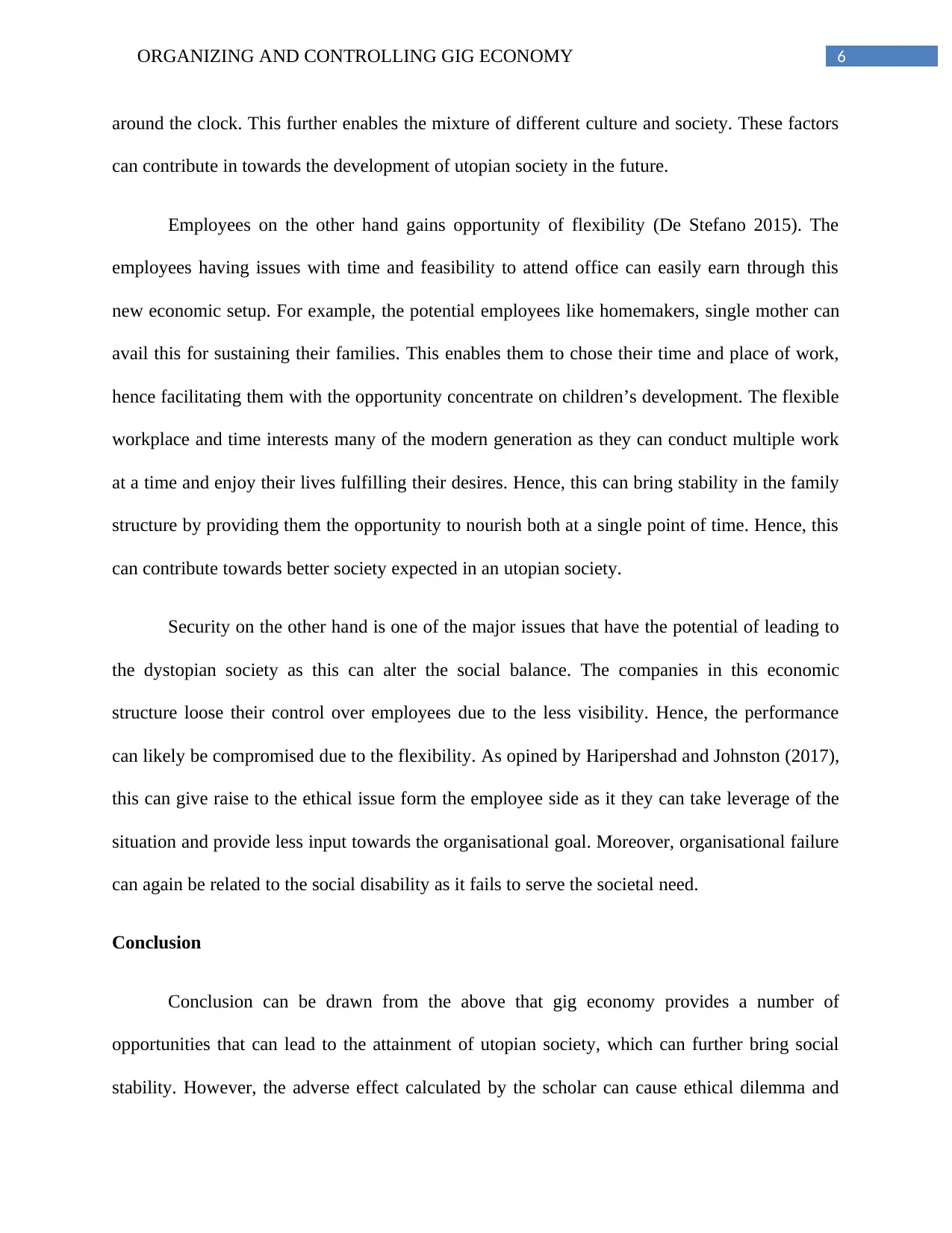
6ORGANIZING AND CONTROLLING GIG ECONOMY
around the clock. This further enables the mixture of different culture and society. These factors
can contribute in towards the development of utopian society in the future.
Employees on the other hand gains opportunity of flexibility (De Stefano 2015). The
employees having issues with time and feasibility to attend office can easily earn through this
new economic setup. For example, the potential employees like homemakers, single mother can
avail this for sustaining their families. This enables them to chose their time and place of work,
hence facilitating them with the opportunity concentrate on children’s development. The flexible
workplace and time interests many of the modern generation as they can conduct multiple work
at a time and enjoy their lives fulfilling their desires. Hence, this can bring stability in the family
structure by providing them the opportunity to nourish both at a single point of time. Hence, this
can contribute towards better society expected in an utopian society.
Security on the other hand is one of the major issues that have the potential of leading to
the dystopian society as this can alter the social balance. The companies in this economic
structure loose their control over employees due to the less visibility. Hence, the performance
can likely be compromised due to the flexibility. As opined by Haripershad and Johnston (2017),
this can give raise to the ethical issue form the employee side as it they can take leverage of the
situation and provide less input towards the organisational goal. Moreover, organisational failure
can again be related to the social disability as it fails to serve the societal need.
Conclusion
Conclusion can be drawn from the above that gig economy provides a number of
opportunities that can lead to the attainment of utopian society, which can further bring social
stability. However, the adverse effect calculated by the scholar can cause ethical dilemma and
around the clock. This further enables the mixture of different culture and society. These factors
can contribute in towards the development of utopian society in the future.
Employees on the other hand gains opportunity of flexibility (De Stefano 2015). The
employees having issues with time and feasibility to attend office can easily earn through this
new economic setup. For example, the potential employees like homemakers, single mother can
avail this for sustaining their families. This enables them to chose their time and place of work,
hence facilitating them with the opportunity concentrate on children’s development. The flexible
workplace and time interests many of the modern generation as they can conduct multiple work
at a time and enjoy their lives fulfilling their desires. Hence, this can bring stability in the family
structure by providing them the opportunity to nourish both at a single point of time. Hence, this
can contribute towards better society expected in an utopian society.
Security on the other hand is one of the major issues that have the potential of leading to
the dystopian society as this can alter the social balance. The companies in this economic
structure loose their control over employees due to the less visibility. Hence, the performance
can likely be compromised due to the flexibility. As opined by Haripershad and Johnston (2017),
this can give raise to the ethical issue form the employee side as it they can take leverage of the
situation and provide less input towards the organisational goal. Moreover, organisational failure
can again be related to the social disability as it fails to serve the societal need.
Conclusion
Conclusion can be drawn from the above that gig economy provides a number of
opportunities that can lead to the attainment of utopian society, which can further bring social
stability. However, the adverse effect calculated by the scholar can cause ethical dilemma and
Paraphrase This Document
Need a fresh take? Get an instant paraphrase of this document with our AI Paraphraser
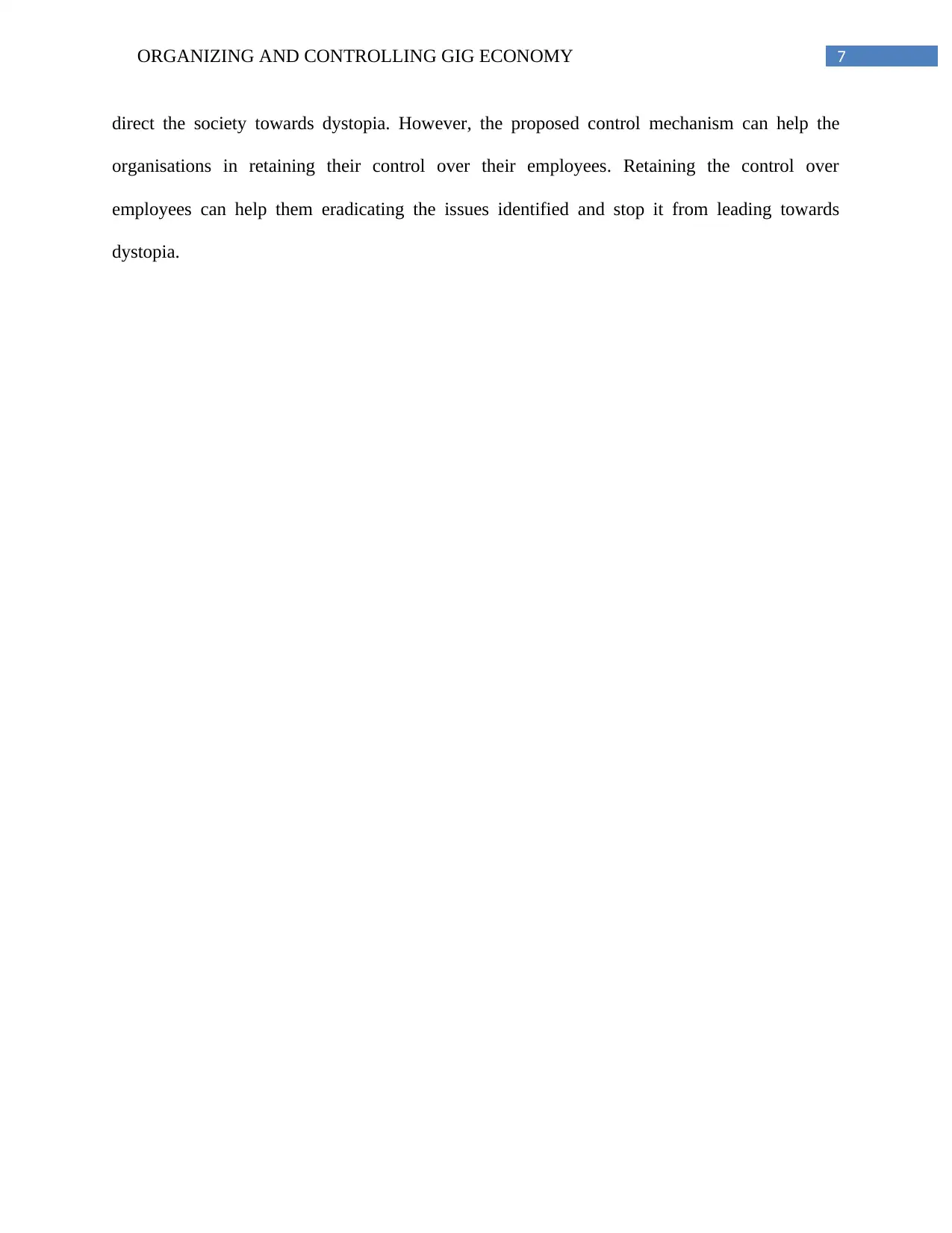
7ORGANIZING AND CONTROLLING GIG ECONOMY
direct the society towards dystopia. However, the proposed control mechanism can help the
organisations in retaining their control over their employees. Retaining the control over
employees can help them eradicating the issues identified and stop it from leading towards
dystopia.
direct the society towards dystopia. However, the proposed control mechanism can help the
organisations in retaining their control over their employees. Retaining the control over
employees can help them eradicating the issues identified and stop it from leading towards
dystopia.
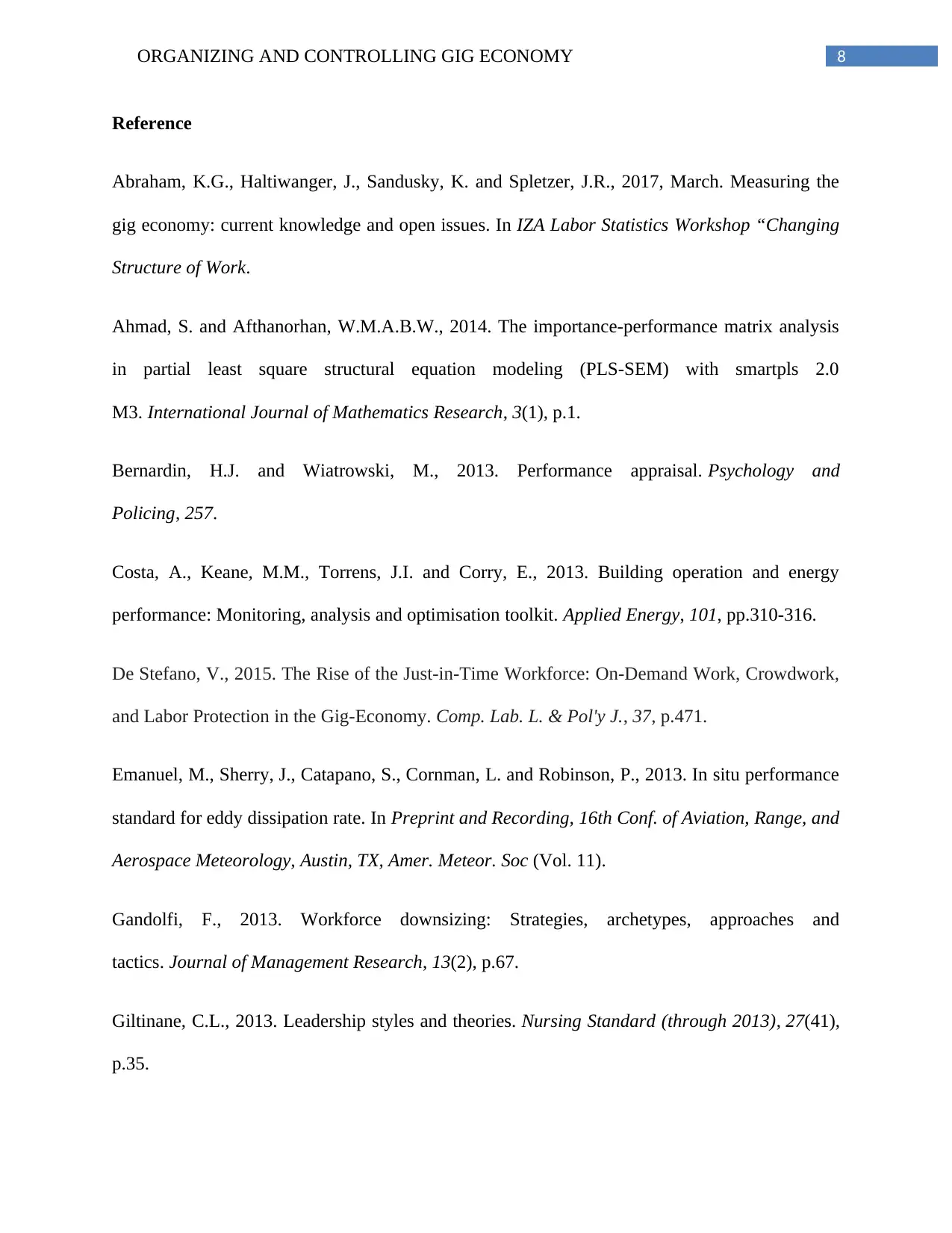
8ORGANIZING AND CONTROLLING GIG ECONOMY
Reference
Abraham, K.G., Haltiwanger, J., Sandusky, K. and Spletzer, J.R., 2017, March. Measuring the
gig economy: current knowledge and open issues. In IZA Labor Statistics Workshop “Changing
Structure of Work.
Ahmad, S. and Afthanorhan, W.M.A.B.W., 2014. The importance-performance matrix analysis
in partial least square structural equation modeling (PLS-SEM) with smartpls 2.0
M3. International Journal of Mathematics Research, 3(1), p.1.
Bernardin, H.J. and Wiatrowski, M., 2013. Performance appraisal. Psychology and
Policing, 257.
Costa, A., Keane, M.M., Torrens, J.I. and Corry, E., 2013. Building operation and energy
performance: Monitoring, analysis and optimisation toolkit. Applied Energy, 101, pp.310-316.
De Stefano, V., 2015. The Rise of the Just-in-Time Workforce: On-Demand Work, Crowdwork,
and Labor Protection in the Gig-Economy. Comp. Lab. L. & Pol'y J., 37, p.471.
Emanuel, M., Sherry, J., Catapano, S., Cornman, L. and Robinson, P., 2013. In situ performance
standard for eddy dissipation rate. In Preprint and Recording, 16th Conf. of Aviation, Range, and
Aerospace Meteorology, Austin, TX, Amer. Meteor. Soc (Vol. 11).
Gandolfi, F., 2013. Workforce downsizing: Strategies, archetypes, approaches and
tactics. Journal of Management Research, 13(2), p.67.
Giltinane, C.L., 2013. Leadership styles and theories. Nursing Standard (through 2013), 27(41),
p.35.
Reference
Abraham, K.G., Haltiwanger, J., Sandusky, K. and Spletzer, J.R., 2017, March. Measuring the
gig economy: current knowledge and open issues. In IZA Labor Statistics Workshop “Changing
Structure of Work.
Ahmad, S. and Afthanorhan, W.M.A.B.W., 2014. The importance-performance matrix analysis
in partial least square structural equation modeling (PLS-SEM) with smartpls 2.0
M3. International Journal of Mathematics Research, 3(1), p.1.
Bernardin, H.J. and Wiatrowski, M., 2013. Performance appraisal. Psychology and
Policing, 257.
Costa, A., Keane, M.M., Torrens, J.I. and Corry, E., 2013. Building operation and energy
performance: Monitoring, analysis and optimisation toolkit. Applied Energy, 101, pp.310-316.
De Stefano, V., 2015. The Rise of the Just-in-Time Workforce: On-Demand Work, Crowdwork,
and Labor Protection in the Gig-Economy. Comp. Lab. L. & Pol'y J., 37, p.471.
Emanuel, M., Sherry, J., Catapano, S., Cornman, L. and Robinson, P., 2013. In situ performance
standard for eddy dissipation rate. In Preprint and Recording, 16th Conf. of Aviation, Range, and
Aerospace Meteorology, Austin, TX, Amer. Meteor. Soc (Vol. 11).
Gandolfi, F., 2013. Workforce downsizing: Strategies, archetypes, approaches and
tactics. Journal of Management Research, 13(2), p.67.
Giltinane, C.L., 2013. Leadership styles and theories. Nursing Standard (through 2013), 27(41),
p.35.

9ORGANIZING AND CONTROLLING GIG ECONOMY
Goetsch, D.L. and Davis, S.B., 2014. Quality management for organizational excellence. Upper
Saddle River, NJ: pearson.
Haripershad, S. and Johnston, K., 2017, July. Impact of the Gig Economy (Uber and AirBnB) in
South Africa. In ECSM 2017 4th European Conference on Social Media (p. 146). Academic
Conferences and publishing limited.
Kenney, M. and Zysman, J., 2015, June. Choosing a future in the platform economy: the
implications and consequences of digital platforms. In Kauffman Foundation New
Entrepreneurial Growth Conference (Vol. 156160).
Lobel, O., 2017. The Gig Economy & The Future of Employment and Labor Law. USFL
Rev., 51, p.51.
McCleskey, J.A., 2014. Situational, transformational, and transactional leadership and leadership
development. Journal of Business Studies Quarterly, 5(4), p.117.
Milberg, W. and Winkler, D., 2013. Outsourcing economics: global value chains in capitalist
development. Cambridge University Press.
Tran, Q. and Tian, Y., 2013. Organizational structure: Influencing factors and impact on a
firm. American Journal of Industrial and Business Management, 3(2), p.229.
Goetsch, D.L. and Davis, S.B., 2014. Quality management for organizational excellence. Upper
Saddle River, NJ: pearson.
Haripershad, S. and Johnston, K., 2017, July. Impact of the Gig Economy (Uber and AirBnB) in
South Africa. In ECSM 2017 4th European Conference on Social Media (p. 146). Academic
Conferences and publishing limited.
Kenney, M. and Zysman, J., 2015, June. Choosing a future in the platform economy: the
implications and consequences of digital platforms. In Kauffman Foundation New
Entrepreneurial Growth Conference (Vol. 156160).
Lobel, O., 2017. The Gig Economy & The Future of Employment and Labor Law. USFL
Rev., 51, p.51.
McCleskey, J.A., 2014. Situational, transformational, and transactional leadership and leadership
development. Journal of Business Studies Quarterly, 5(4), p.117.
Milberg, W. and Winkler, D., 2013. Outsourcing economics: global value chains in capitalist
development. Cambridge University Press.
Tran, Q. and Tian, Y., 2013. Organizational structure: Influencing factors and impact on a
firm. American Journal of Industrial and Business Management, 3(2), p.229.
1 out of 10
Related Documents
Your All-in-One AI-Powered Toolkit for Academic Success.
+13062052269
info@desklib.com
Available 24*7 on WhatsApp / Email
![[object Object]](/_next/static/media/star-bottom.7253800d.svg)
Unlock your academic potential
© 2024 | Zucol Services PVT LTD | All rights reserved.





